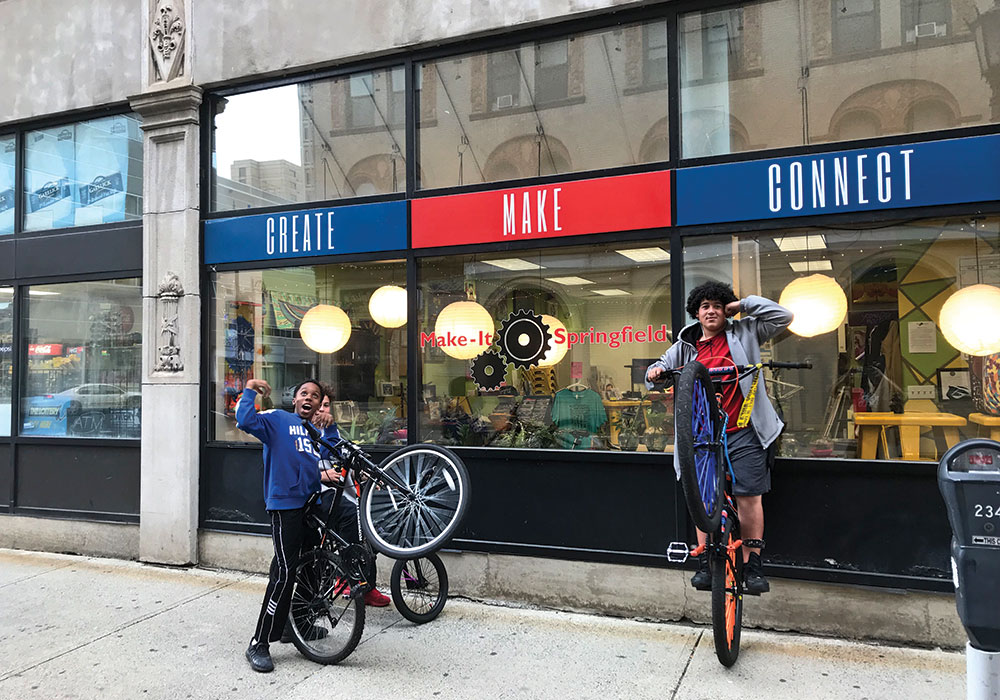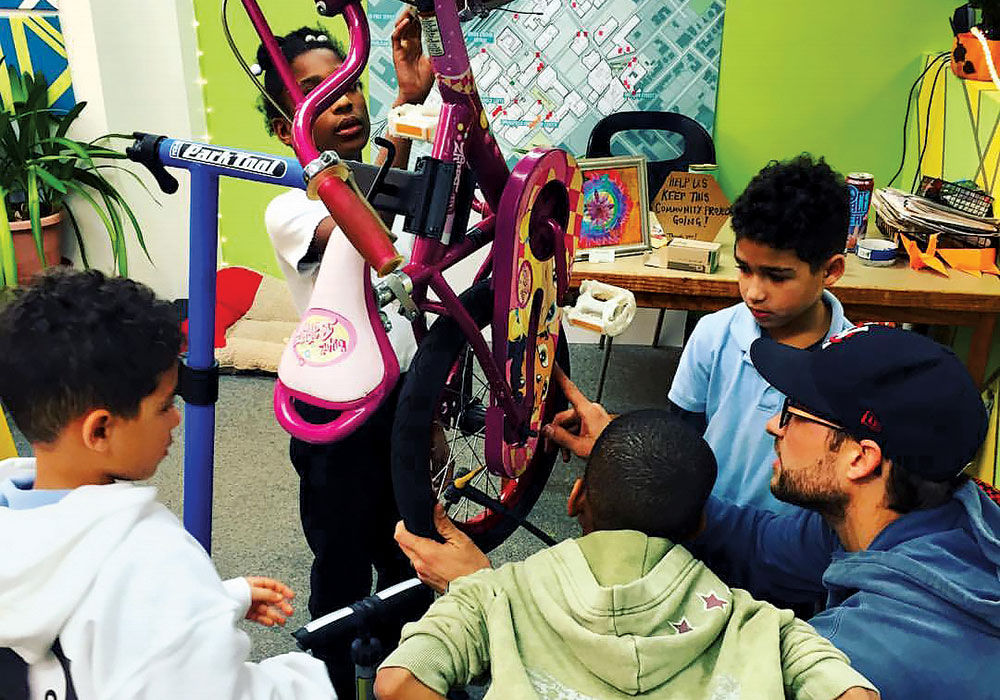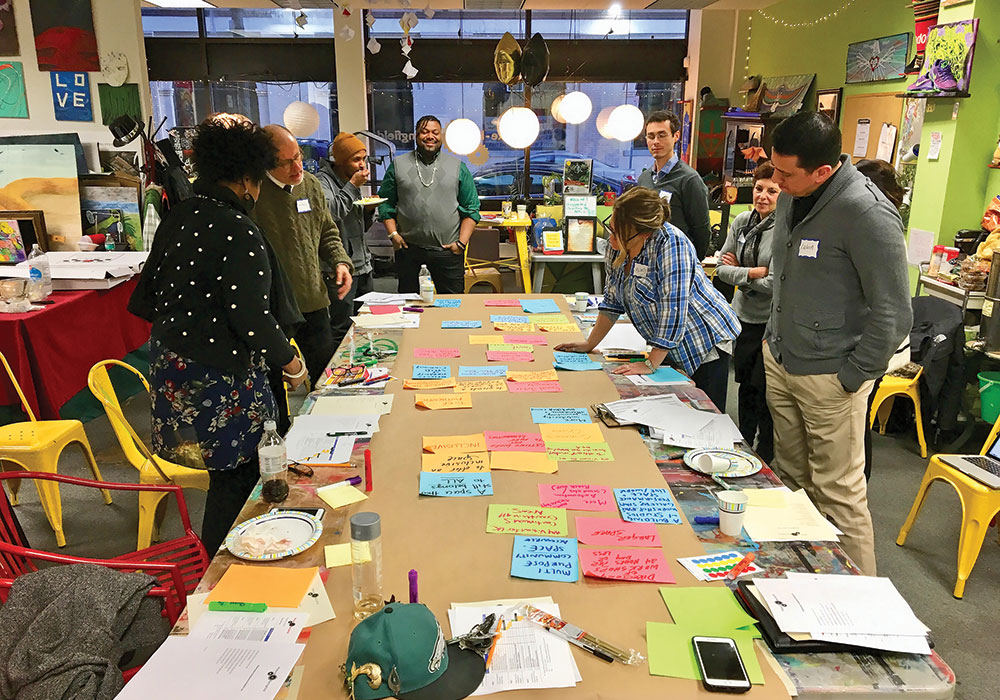Planning October 2019
Make It, Springfield
Spearheaded by a nearby university, a collaborative workspace is breathing new life into a Massachusetts legacy city.
By Michael Di Pasquale, AICP, AIA
A black-and-white photograph of 1940s Springfield, Massachusetts, hangs in my office in the Department of Landscape Architecture and Regional Planning at the University of Massachusetts Amherst. The picture captures a common scene in the U.S. before and just after World War II: an electric trolley flanked by automobiles, sidewalks crowded with people, active businesses in brick buildings with wood and glass storefronts lining the street. A downtown full of life.
Like many of the country's former industrial "legacy" cities, Springfield's fortunes reversed soon after the war as manufacturing moved south or overseas. When the Springfield Armory, a longtime munitions facility for the federal government, shut down in 1968, a downward spiral of factory closings, job losses, and increased poverty followed. Subsequent urban renewal projects displaced residents and cut the city off from its waterfront, while urban flight and suburbanization shrank the population and withdrew much-needed resources as nearby towns flourished.
According to the 2017 report Revitalizing America's Smaller Legacy Cities, larger legacy cities like Pittsburgh and Milwaukee have been making a comeback after decades of decline, but their smaller, mid-sized counterparts are having a harder time rebounding.
That's certainly been the case for Springfield (pop. 155,000) — or at least it was.
After years of false starts, the city's revitalization efforts are beginning to gain momentum. In the last two years alone, Mayor Domenic Sarno and the Department of Planning and Economic Development have renovated many of the city's parks and public spaces. The long-dormant downtown train station has been transformed into a busy multimodal transit hub with added commuter rail service. Bike lane and placemaking initiatives are under way, and new businesses have launched, including a $1 billion MGM resort casino downtown that has create close to 2,300 direct jobs and is drawing thousands of visitors (40 percent from outside the region) since opening in 2018.
But before the new transit hub and billion-dollar casino, it was a community workspace that helped kick things off on a forgotten downtown thoroughfare.

When Make-It Springfield moved into an empty storefront, it helped kick off the revitalization of this older manufacturing city. A new transit hub and a downtown casino are among the businesses and initiatives that have followed. Photo by Laura Masulis.
Make-It Springfield by the Numbers
Make-It Springfield celebrated its three-year anniversary in June — and has come a long way since its first month-long experiment. Its vision statement says it all: "A creative workshop place for everyone. A place for people to build relationships, launch businesses, and inspire one another."
400+ participants each month
150 participants each week in the first month
22 maker members
4+ creative businesses incubating
30+ workshops each month
$50,000 in grant funding to date
Source: Make-It Springfield
A creative oasis
As part of the University of Massachusetts Amherst Extension program, I've worked in Springfield, 25 miles from campus, for just over 10 years, exploring ways a university-community collaboration can address challenges like high poverty, empty lots, and vacant storefronts.
In 2016, after organizing a few successful university-community design projects around town, I connected with Laura Masulis, the city's newly appointed Transformative Development Fellow, a position funded by MassDevelopment, a Massachusetts economic development agency tasked with implementing creative, targeted interventions in the state's older manufacturing cities. At the time, I was working on a research project with Lara Furtado, a UMass PhD student in regional planning, looking at new ways the university could engage with the community that were less institutional and more empowering for residents. I had also just finished teaching a graduate urban design studio that highlighted the benefits of redesigning vacant spaces in Springfield and the importance of creating active first floors.
We pitched the idea of testing our research by transforming a vacant downtown storefront into a makerspace staffed by UMass faculty and students for 30 days. For the project to make an impact, it "needed to have the lights on for most of the day, every day of the month," Masulis told us.
She directed us to a first-floor storefront on Worthington Street, a major artery lined with impressive masonry buildings — many mostly empty — and an easy walk to Main Street, the business district, Springfield's Museum Quadrangle, and the historic armory. Formerly used for offices, the 1,500-square-foot space had been vacant for almost two years. It was dark and narrow, with two tiny bathrooms and a windowless office squeezed into the back.
MassDevelopment and UMass Extension kicked in a small amount of seed funding to help pay for furniture and paint, and with the help of a half-dozen UMass students and a few other volunteers, Masulis and I scrubbed toilets, washed windows, and implemented a DIY makeover plan: lime green paint and Christmas lights. Over Memorial Day weekend (with no electricity or air conditioning), we decorated the large front windows with white paper lanterns and pasted our name and new logo on the glass.
On the first Saturday of June 2016, less than a month after that initial meeting with Masulis, Make-It Springfield debuted with a community open house. Ten volunteers, mostly UMass colleagues and students of mine, organized free activities like 3-D printing, Lego block building, electronic quilting, wood bridge building, and oil painting. Outside, an engineering student taught kids to fly drones.
The community's response was even better than we anticipated. More than 150 people showed up, including local artist Sheldon Smith and his daughter, Nevaeh. Today, Smith is a member of Make-It's advisory board. When he walked in that first day, he saw "an oasis" for artists like him, he says, a place "that was totally accessible and community oriented."
Letting the community lead
We've come a long way since that first Saturday. Our one-month experiment celebrated its three-year anniversary last June, and the project keeps growing.
"We piloted a concept first and let the community lead the process," says Masulis. "Now, we have a community of makers and artists, a vibrant storefront presence, and hundreds of people visiting the makerspace — and neighborhood — each month, leaving inspired."
A core group of about a dozen volunteers comprise the advisory board. They discuss everything from how to pay rent to what to do when the upstairs tenants think the salsa classes are too loud. We also have about two dozen paying members ($30 a month) with unlimited use of the space and equipment. Recent workshops include a well-attended Art for Adults Studio, sewing classes, 3-D printing, poetry workshops, and ceramics. On Monday afternoons, a popular DIY bike workshop, organized weekly by local nonprofit RAD Springfield, packs the space. A special needs workforce development group and home school group also host weekly arts and craft sessions.
Artist Marla Shelasky, a maker from our advisory board, says Make-It provides "the only space in the city where artists feel welcome and wanted. It's not an intimidating space, it's a place where things are made, and where artists are visible. It's the kind of place where change in the community can happen."

RAD, Springfield's Mobile Community Bike Shop, hosts a popular DIY bike workshop on Monday afternoons. It's one of several classes and workshops hosted by community organizations at Make-It Springfield. Photo by Michael Di Pasquale.
An economic boost
On Tuesdays during the semester you can find me at the workspace, teaching a dozen Springfield 4-H students about urban design. A former 4-H student, Briyanna Henry, (now a UMass sophomore) told me recently that she "didn't think anything was happening downtown" until she found out about Make-It Springfield.
While Worthington Street had many vacant storefronts when Make-It Springfield moved in, it was also home to several popular bars and restaurants, plus a collection of historic older buildings. Make-It Springfield has added something new to the street and has helped it become a welcoming and active public space once again. Brightly lit and attractive, our storefront not only brings a new vibrancy to Worthington Street, it also serves as an incubator, where small businesses can test and sell new products.
"Makerspaces are becoming very popular, but not many can claim to keep the community aspect at the forefront of what they want to accomplish," says Michelle LaRocque, owner of a local handmade soap company. "It has been especially important to me as a small business owner because it has introduced me to so many other entrepreneurs, artists, local Springfield businesses, and more. It has helped my business grow locally and allowed me opportunities to collaborate with these other local start-ups and make special products for them as well."
In a video made recently by one of my students, former Springfield City Council member Amaad Rivera said he has "seen a physical transformation in the downtown area" since Make-It opened. The workspace is "changing people's lives" by bringing in more foot traffic, he said, leading to fewer empty storefronts. The space next to us, vacant for many years, is now occupied, and one of our makers recently purchased a building down the street where he intends to base his expanded 3-D printer training business. A new local cookie company and two new restaurants have also opened within walking distance.

The author (second from left) at a strategy session with a group of community advisors. Photo by Laura Masulis.
Looking forward
One evening last summer, close to 100 local residents met to talk about future plans for the workspace. In true planning fashion, what started as a patchwork of sticky notes on a wall became a vision statement: Make-It Springfield will strive to be "a creative workshop space for everyone. A place for people to build relationships, launch businesses, and inspire one another."
To realize that vision, we are looking at ways to expand our workspace while maintaining our presence in the downtown area. We are also developing more connections to the burgeoning local network of innovative organizations, including Valley Venture Mentors, a group promoting start-up businesses, and Develop Springfield, a nonprofit developer located in the nearby Innovation Center. We also partner with the Springfield Museums, where a new Dr. Seuss museum is drawing large crowds.
The days of one-size-fits-all economic development projects are over — and the city and state are beginning to understand that fact. Springfield's mayor has expressed his support for our lighter, more tactical approach to development, providing funding each year for the urban design studios I run in the city with my UMass colleague Frank Sleegers. And earlier this year, Massachusetts Governor Charlie Baker visited Make-It Springfield to offer his own praise.
"When you start something that is supposed to be a 30-day gig and it is still in operation almost three years later," he said, "that says something positive about what you are up to and what you are doing."
Michael Di Pasquale is an extension assistant professor at the University of Massachusetts Amherst where his research and teaching focus on the revitalization of America's legacy cities. A planner and registered architect, he is the cofounder of Make-It Springfield.


